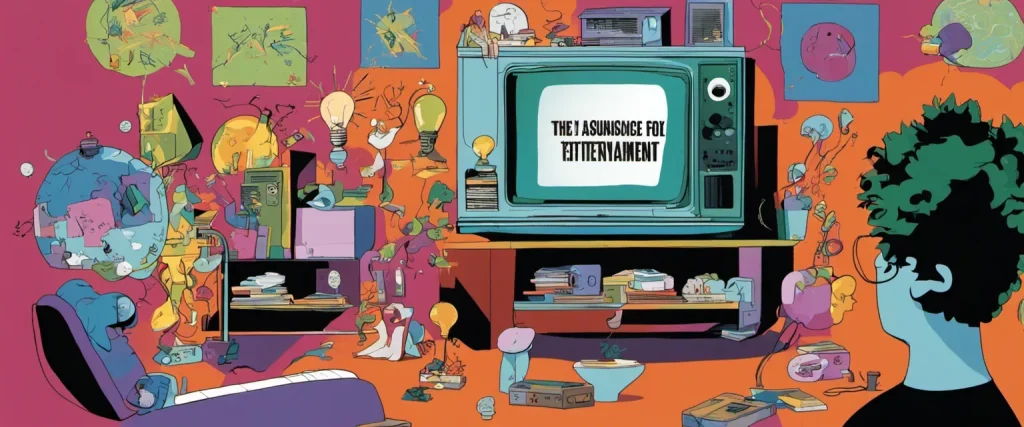In his renowned work, “Amusing Ourselves to Death,” Neil Postman explores the detrimental effects of the media on our culture and society. Published in 1985, this book serves as a compelling warning against the dangers of a society driven by entertainment rather than intellectual discourse. As a cultural critic and media theorist, Postman was renowned for his thought-provoking insights on the impact of technology on human communication, education, and politics. Throughout his career, he fervently argued that the medium through which information is conveyed is just as important as the content itself, recognizing the power of television as a medium that shapes our collective worldview. In “Amusing Ourselves to Death,” Postman presents a comprehensive analysis of how our addiction to entertainment has eroded our ability to think critically and engage in meaningful dialogue, making the case for a more conscientious approach towards media consumption.
Chapter 1: The Medium is the Metaphor
Chapter 1: The Medium is the Metaphor of “Amusing Ourselves to Death” by Neil Postman introduces the central thesis of the book – that the medium through which information is conveyed shapes how people perceive and understand the world. Postman argues that the rise of television as a dominant medium in society has fundamentally altered the way people think, transforming public discourse into entertainment.
Postman begins by contrasting the dystopian vision of George Orwell’s “1984,” in which oppressive governments control people through censorship and surveillance, with the vision of Aldous Huxley’s “Brave New World,” in which people are controlled by an infinite array of distractions and superficial pleasures. According to Postman, Huxley’s vision is the more accurate of the two, as he believes that humanity is not being oppressed by censorship but is willingly surrendering critical thinking and meaningful dialogue in favor of mindless entertainment.
He argues that the printing press, which dominated information dissemination for centuries, gave priority to rational, analytical thinking and promoted a culture of serious discourse. However, television, with its visual and audio stimulation, prioritizes entertainment and triviality over serious thought. The medium of television, he claims, has transformed education, politics, news, and religion into forms of entertainment, reducing complex issues to simplistic sound bites and superficial imagery.
Postman further describes how television, as an image-centered medium, has changed the nature of public discourse. He cites examples of how politicians have embraced image-based techniques to manipulate their image and connect with the public, rather than engaging in substantive policy debates. Additionally, he argues that television’s nature as a medium of entertainment has diminished our ability to engage in serious intellectual conversations, as people now seek momentary pleasure and gratification rather than deep understanding.
In conclusion, in “The Medium is the Metaphor,” Postman sets the stage for his analysis of how television’s influence as a medium has transformed society by promoting shallow entertainment and undermining serious discourse and critical thinking.
Chapter 2: Media as Epistemology
Chapter 2 of Neil Postman’s book “Amusing Ourselves to Death” is titled “Media as Epistemology.” In this chapter, Postman explores the idea that different media forms, such as print and television, shape the way we think and how we understand the world.
Postman starts by emphasizing the importance of understanding the medium itself, rather than just its content. He argues that the way information is presented to us significantly influences the way we perceive reality, because each medium has its biases and limitations. Print, for example, encourages rational thinking, detached analysis, and long-form arguments. Television, on the other hand, favors visual images, entertainment, and emotional impact.
According to Postman, the medium of television has transformed our culture into a world that values entertainment above all else. He argues that television has turned public discourse into mere entertainment, making serious matters, such as politics and education, appear trivial and shallow. As a result, people are becoming less well-informed citizens who are easily swayed by superficial soundbites rather than deep, thoughtful analysis.
Postman suggests that television’s influence has spread beyond politics and into education as well. He believes that schools are increasingly adopting an entertainment-oriented approach to teaching, focusing on making learning enjoyable and engaging rather than fostering critical thinking skills. This, in turn, hampers students’ ability to analyze complex information and distinguish between fact and opinion.
In conclusion, this chapter highlights Postman’s argument that media shapes our perception of reality. Television has pushed our culture towards valuing entertainment over substance, leading to a lack of critical thinking and a society easily swayed by media manipulations. Media forms, therefore, have the power to shape not only what we know but also how we know it.
Chapter 3: Typographic America
In Chapter 3, titled “Typographic America,” Neil Postman explores the impact of typography and print culture on American society in the 18th and 19th centuries. He discusses how the rise of literacy and print media influenced the way people thought, communicated, and shared information during that era.
Postman argues that typographic culture fostered rational thought and critical thinking. He highlights the significance of long, complex sentences and detailed arguments prevalent in written texts of that time. These formats demanded focused attention and provided opportunities for deeper analysis and reflection. Moreover, the print culture fostered a sense of dialogue and debate, where ideas were often shared and discussed in public forums.
Postman contrasts this with the advent of electronic media, particularly television, which he believes has drastically altered the way information is presented and consumed. Television, as a visual and oral medium, emphasizes instant gratification and entertainment over thoughtful analysis. It appeals to emotions rather than intellect, relying on visual stimulation to capture attention. Postman argues that television has transformed public discourse into a fragmented, shallow, and superficial form, reducing complex ideas into easily digestible sound bites and images.
Furthermore, Postman asserts that the medium in which information is presented significantly impacts the content and context of that information. He suggests that understanding the medium’s inherent biases and limitations is crucial in evaluating the messages and knowledge it conveys.
In “Typographic America,” Postman presents a historical perspective on the effects of media on society, laying the groundwork for his later arguments about the impact of television and the dangers of a visually-driven culture.
Chapter 4: The Typographic Mind

In Chapter 4 of “Amusing Ourselves to Death” titled “The Typographic Mind,” Neil Postman discusses the impact of typography on human communication and thought processes. He argues that before the rise of television and visual media, people relied heavily on the written word, which shaped their cognitive abilities and worldviews.
Postman highlights how typography creates a medium of communication that requires readers to think analytically, reflect deeply, and engage intellectually. He describes how the printed word fosters a linear, logical, and coherent way of thinking. Readers are required to develop the skills of sustained attention, critical analysis, and logical reasoning to comprehend and interpret written texts.
Furthermore, Postman notes that typography promotes a public discourse rooted in rationality. Through books, newspapers, and lengthy articles, the public had access to detailed, complex, and well-reasoned arguments. This encouraged deep reflection, contemplation, and the formation of well-constructed ideas and opinions.
However, the advent of visual media, particularly television, has transformed our thinking processes. Postman argues that television’s emphasis on entertainment, brevity, and sensationalism eroded the capabilities fostered by typography. The visual images, fragmented soundbites, and lack of intellectual depth in television programming have led to a decline in critical thinking, attention span, and public discourse.
Postman believes that the shift from typography to visual media has resulted in the dominance of imagery over language, entertainment over education, and superficiality over substance. He warns that this shift poses significant implications for democracy, as citizens are more inclined to be passive consumers rather than active participants in political decision-making.
Overall, Postman’s “The Typographic Mind” sheds light on the profound influence of typography on human cognition and the subsequent consequences of its decline in the face of visual media.
Chapter 5: The Peek-a-Boo World
Chapter 5 of “Amusing Ourselves to Death” by Neil Postman, titled “The Peek-a-Boo World,” explores the impact of television on public discourse and the way in which it shapes our understanding of reality. Postman argues that television, with its focus on entertainment and instant gratification, has reduced important issues to mere spectacles and transformed public discourse into a form of entertainment.
Postman begins the chapter by comparing the serious and rational nature of the written word with the influence of television. He argues that, unlike written language, television prioritizes the visual and the immediate, leading to a society in which people are more concerned with being entertained than informed. This has significant consequences for how we perceive and engage with important societal issues.
Television, according to Postman, promotes a fragmented worldview where news, politics, and even religion are reduced to snippets, soundbites, and images. He suggests that television’s emphasis on brevity and visual appeal leads to an oversimplification of complex topics, making them more accessible but lacking depth and nuance. This “peek-a-boo” nature of television creates a sense of constant distraction and prevents us from engaging in critical thinking and reflection.
Postman also discusses the impact of advertising on television, noting that it further trivializes information by presenting it in a way that is primarily aimed at capturing attention rather than conveying substance. He argues that this emphasis on the image rather than the message shapes our culture, influencing how we perceive and interact with the world.
In conclusion, Chapter 5 of “Amusing Ourselves to Death” highlights how television contributes to the transformation of public discourse into a form of entertainment. Postman cautions against the dangers of a society more concerned with amusement than with thoughtful reflection, ultimately sacrificing the pursuit of knowledge and critical thinking.
Chapter 6: The Age of Show Business
Chapter 6 of “Amusing Ourselves to Death” by Neil Postman is titled “The Age of Show Business” and focuses on the rise of television as the dominant form of communication and entertainment in society.
Postman begins by highlighting the shift from a typographic culture to a televisual culture. He argues that television has fundamentally altered the way we think and perceive the world, emphasizing entertainment and triviality over serious discourse. According to Postman, society has been engulfed by a sea of TV shows, commercials, and infotainment that shape our values, beliefs, and understanding of reality.
The chapter explores the concept of news as entertainment. Postman contends that television news has transformed into a form of show business, where the style and presentation often outweigh the substance and importance of the content. He criticizes the rise of image-based politics, where political candidates are marketed like products, judged by their appearance, charisma, and ability to perform on camera, rather than their ideas and policies.
Postman also delves into the role of advertising in the television culture. He argues that advertising has become the most powerful medium of social communication, shaping our desires, values, and lifestyles. Advertisements create artificial needs and promote consumerism, encouraging people to seek happiness and fulfillment through the acquisition of material possessions.
Additionally, Postman discusses how public discourse has been negatively affected by television. He argues that television’s emphasis on entertainment has made serious and thoughtful discussions difficult, if not impossible. He points out that complex issues and debates are condensed into soundbites, reducing complex ideas to catchy slogans or attention-grabbing visuals.
Overall, Chapter 6 of “Amusing Ourselves to Death” paints a critical picture of the age of show business brought about by television. Postman argues that this shift has transformed society into one focused on entertainment and instant gratification, where substantive discourse and critical thinking are marginalized.
Chapter 7: “Now…this”
Chapter 7 of “Amusing Ourselves to Death” by Neil Postman, titled “Now…this,” explores the impact of television news on public discourse and the decline of serious journalism. Postman argues that television’s format and reliance on visual images have fundamentally transformed the way news is presented and received, resulting in a shift towards entertainment-oriented content.
Postman begins by contrasting the typographical culture of the past, where print media encouraged rational and analytical thought, with the visual culture of television, which emphasizes emotional impact and instantaneous gratification. He criticizes the news media for creating a fragmented and superficial view of the world, as television news tends to prioritize sensationalism and entertainment value over substantive reporting.
Drawing examples from various news programs, Postman illustrates how the traditional boundaries between news, entertainment, and advertising have become blurred, leading to a deterioration in the quality of information presented. He explains that television’s format, characterized by short segments and rapid cuts, encourages viewers’ passive consumption of news rather than thoughtful engagement with the issues at hand.
Moreover, Postman argues that television’s influence has led to a devaluation of words and the rise of image-centric communication. He claims that the pervasive presence of television has eroded the public’s ability to engage in reasoned debate and critical thinking, as images inherently lack depth and nuance compared to the written word.
Ultimately, Postman suggests that the dominance of television as a medium for news consumption has resulted in a society that prioritizes entertainment over enlightenment. He urges readers to recognize the perils of relying solely on television for information and to restore the importance of thoughtful discourse and rational analysis in public life.

Chapter 8: Shuffle Off to Bethlehem
Chapter 8: Shuffle Off to Bethlehem of the book “Amusing Ourselves to Death” by Neil Postman discusses the impact of television on religion. Postman argues that television has transformed religious experiences into shallow, entertainment-driven spectacles. He begins by highlighting how religion was once based on the written word and required deep reading and intellectual engagement. However, television’s visual nature has shifted the focus from rational thinking to visual stimulation.
Postman asserts that the rise of televangelism has turned religion into a show, where preachers present their message as entertainment, complete with flashy performances and catchy slogans. He criticizes this transformation, claiming that the true essence of religious worship, which involves meaningful reflection and introspection, is lost in this superficial presentation.
Furthermore, Postman warns about the dangers of television’s ability to distort religious practices. He cites examples of religious programs that offer quick fixes, materialistic prosperity, and miracle cures, which he believes exploit people’s vulnerabilities. Television’s demand for constant stimulation and instant gratification encourages viewers to seek immediate results, undermining the essence of spirituality and religious traditions.
Postman emphasizes the loss of sacredness brought about by television’s pervasive influence. He argues that religion, when transformed into mere entertainment, loses its power to provide moral guidance and reflect upon profound existential questions. Instead, it becomes another form of mindless amusement that distracts individuals from engaging with pressing societal issues.
In conclusion, Chapter 8 highlights how television has transformed religion by turning it into a shallow, entertainment-focused spectacle. Postman raises concerns about the trivialization and commodification of spirituality, warning that this shift undermines the true transformative power that religion once possessed.
After Reading
In Neil Postman’s thought-provoking book Amusing Ourselves to Death, he argues that the shift from a print-based culture to a visual culture driven by the entertainment industry has had profound effects on society. Postman contends that the prevalence of television and other forms of media have created a society that values entertainment above all else, leading to a decline in critical thinking, a loss of meaningful public discourse, and a distortion of information. He warns that the constant inundation of images and soundbites has resulted in a populace incapable of engaging in serious discussions about important issues. Through a historical analysis and examination of various media forms, Postman presents a compelling case for the need to reevaluate our current cultural values and priorities. Ultimately, he emphasizes the importance of preserving intellectual discourse and the written word in order to cultivate a more informed and engaged society. Amusing Ourselves to Death serves as a critical wake-up call, urging readers to be mindful of the potential dangers of a society that prioritizes entertainment over thoughtful analysis and meaningful dialogue.
1. The Shallows” by Nicholas Carr – In this thought-provoking book, Carr explores how the internet is impacting our cognitive abilities and reshaping the way we think. He raises important questions about the effects of constant online connectivity on our attention span and critical thinking skills.
2. Deep Work” by Cal Newport – Building on the themes addressed in “The Shallows,” Newport provides practical advice on how to cultivate deep focus and achieve productivity in a world filled with distractions. He outlines strategies to sharpen our ability to dive deep into important tasks and produce high-quality work.
3. The Information” by James Gleick – Gleick delves into the fundamental nature of information itself, tracing its origins back to ancient civilizations and following its development through various milestones in human history. He examines how information has shaped society, language, science, and technology, and he discusses the profound influence it continues to have on our lives today.
4. “Digital Minimalism” by Cal Newport – In this modern age of constant digital connectivity, Newport offers a refreshing perspective on how to regain control over our personal lives. He advocates for a deliberate and intentional approach to technology use, encouraging readers to declutter their digital lives and create space for meaningful activities and deep thinking.
5. Everybody Lies” by Seth Stephens-Davidowitz – The book delves into the world of big data, examining the vast amounts of information generated through internet searches, social media activity, and other online platforms. Stephens-Davidowitz argues that these digital footprints provide a unique window into human behavior and offer valuable insights that traditional methods often fail to capture.



